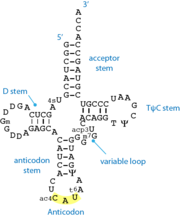Transfer RNA (tRNA)
From Proteopedia
(Added schematic drawing of the 2D cloverleaf structure) |
m (→Structure - simplified anticodon scene) |
||
| Line 17: | Line 17: | ||
==Structure== | ==Structure== | ||
| - | The structure of most tRNA is composed of <scene name='TRNA/Fullview_cartoon/1'>four helical stems</scene> arranged in a cloverleaf structure with four helical stems and an central four-way junction. The <scene name='TRNA/Acceptor_cartoon/1'>acceptor stem</scene> comprises the 5' and 3' ends of the molecule, the latter having an extension of four unpaired nucleotides, with a conserved terminal -CCA sequence at the 3' end. The anticodon stem, at the other end of the molecule is closed by the <scene name='TRNA/ | + | The structure of most tRNA is composed of <scene name='TRNA/Fullview_cartoon/1'>four helical stems</scene> arranged in a cloverleaf structure with four helical stems and an central four-way junction. The <scene name='TRNA/Acceptor_cartoon/1'>acceptor stem</scene> comprises the 5' and 3' ends of the molecule, the latter having an extension of four unpaired nucleotides, with a conserved terminal -CCA sequence at the 3' end. The anticodon stem, at the other end of the molecule is closed by the <scene name='TRNA/Anticodon_cartoon/2'>anticodon</scene> loop. The TΨC-stem and loop and the D-stem and loop form the core of the molecule. |
The overall shape of the molecule is that of a capital "L" letter. The two arms of the "L" are formed by the stacking of the acceptor and TΨC-stem on one side, and of the anticodon and D-stem on the other side. Tertiary interactions between the TΨC- and D-loop form the corner of the L-shape and stabilise the structure. | The overall shape of the molecule is that of a capital "L" letter. The two arms of the "L" are formed by the stacking of the acceptor and TΨC-stem on one side, and of the anticodon and D-stem on the other side. Tertiary interactions between the TΨC- and D-loop form the corner of the L-shape and stabilise the structure. | ||
Revision as of 08:25, 10 January 2011
tRNA or transfer RNA is stable, structured RNA present in all living cells. tRNA participates in the process of protein translation by the ribosome. Varying tRNA molecules carry a specific amino acid esterified on their 3'-OH group (the acceptor end). They also carry a specific triplet sequence, the anticodon, which pairs with its complementary codon on the messenger RNA, within the ribosome.
Cells usually have sets of tRNAs corresponding to all 20 standard amino acids, with anticodons capable of pairing with the 61 "sense" or coding codons. The secondary structure of tRNA is well conserved throughout evolution, with a classical cloverleaf fold comprising four stems. In three dimensions, tRNA adopt an "L" shape, with the acceptor end on one end and the anticodon on the other end.
After incorporation of the amino acid into the nascent protein chain by the ribosome, tRNA need to be esterified again ('charged') with their cognate amino acid, a process which is catalysed by a family of enzymes called aminoacyl-tRNA synthetases.
Contents |
Modified nucleotides
Most tRNAs contain modified nucleotides[1], which are added post-transcriptionally by specific enzymes. Common modifications include isomerisation of uridines into pseudouridines (Ψ), methylation of either the ribose and/or the base, thiolation, reduction of uridines into dihydrouridines (D). The anticodon loop of the tRNA quite often contains hypermodified bases, the function of which is to stabilise the codon-anticodon interaction within the ribosome. The nature and position of nucleotide modifications is both specific of the organism and the tRNA type.
|
Common modified nucleotides include :
- (ribothymidine) at position 54
- pseudouridine at position 55
- dihydrouridine(s) in the D-loop
- 7-methylguanosine at position 46
- 4-thiouridine at position 8
Structure
The structure of most tRNA is composed of arranged in a cloverleaf structure with four helical stems and an central four-way junction. The comprises the 5' and 3' ends of the molecule, the latter having an extension of four unpaired nucleotides, with a conserved terminal -CCA sequence at the 3' end. The anticodon stem, at the other end of the molecule is closed by the loop. The TΨC-stem and loop and the D-stem and loop form the core of the molecule.
The overall shape of the molecule is that of a capital "L" letter. The two arms of the "L" are formed by the stacking of the acceptor and TΨC-stem on one side, and of the anticodon and D-stem on the other side. Tertiary interactions between the TΨC- and D-loop form the corner of the L-shape and stabilise the structure.
In addition, tRNA have a variable loop located in between the acceptor and D-stems. This variable loop can be quite small, but for some tRNA such as the serine or leucine-specific tRNA, it can form an additional helix.
References
- ↑ Motorin Y, Helm M. tRNA stabilization by modified nucleotides. Biochemistry. 2010 Jun 22;49(24):4934-44. PMID:20459084 doi:10.1021/bi100408z
Reference for the structure
- Shi H, Moore PB. The crystal structure of yeast phenylalanine tRNA at 1.93 A resolution: a classic structure revisited. RNA. 2000 Aug;6(8):1091-105. PMID:10943889
3D Structures of tRNA
- 1ehz
- 1evv
- 4tna
- 6tna
- 1tra
- 2tra
- 3tra
- 4tra
- 1wz2
- 1bz2
- 1bz3
- 1bzt
- 1bzu
- 1efw
- 1feq
- 1fl8
- 1gax
- 1j1u
- 1ttt
- 2jrq
- 3ok7
- 3ova
- 3f1h
- 486d
See Also
Proteopedia Page Contributors and Editors (what is this?)
Karsten Theis, Wayne Decatur, Michal Harel, Frédéric Dardel, Ann Taylor, Joel L. Sussman, Alexander Berchansky
Categories: Trna | Topic Page | Translation | Modification | RNA | Amino acid

